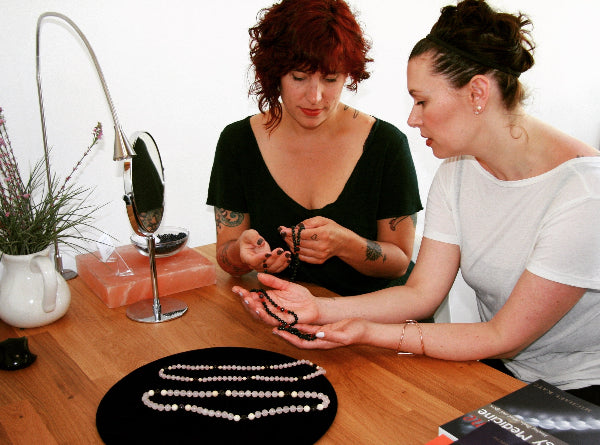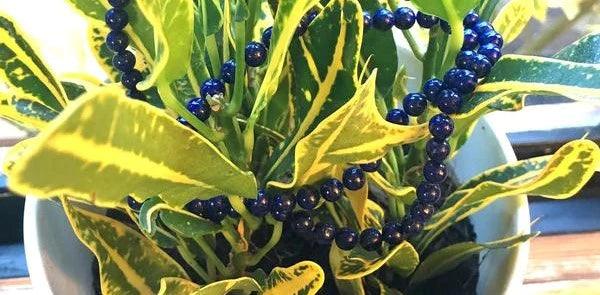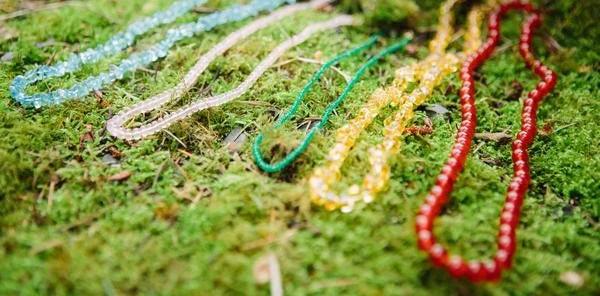Gemstone Cleansing – Your Questions Answered – PART 3: Water Rinse
Part 3: Water Rinse
This is the third of a five-part series in which Gemisphere Office Manager Michelle answers your questions about how to energetically cleanse your therapeutic gemstones. Upcoming posts will feature the Sun Bath and Clay Cleanse methods. Read Part 1: Salt Bed here, and Part 2: Plant Rejuvenation here.
The quickest way to cleanse certain therapeutic gemstones is the Water Rinse. This makes it a great technique when you’re on the go or when you want to wear your gems almost continuously. It’s also handy after you’ve used your necklace for a focused treatment and want to wear it soon thereafter. I love the Water Rinse because it not only cleanses the gemstones of unwanted energies but also removes dirt and oil, so they feel extra refreshed and clean.
CAUTION: Unlike the Salt Bed and Plant Rejuvenation methods, the Water Rinse is not appropriate for all gemstones, so be sure to read the specific care instructions card that came with your gemstones. At the end of this post, I list the gems that can be safely cleansed with the Water Rinse and the ones that should avoid it.
What is the Water Rinse?
In the Water Rinse, you simply hold your gems under alternating warm and cold running water. The changing temperatures gently shock the gemstones into releasing the disharmonious energies that naturally collect on the gems’ surface during the course of their therapeutic work. The moving water carries those energies away.

How do I perform the Water Rinse?
Grasp two or three gems in the necklace so that most of the necklace dangles down from your fingertips, and hold it under running water. Don’t cup the gemstones in your hands; you want the water to run down the gems and into the sink, not pool in your palm. Turn the tap to warm until you feel the gems warm up—a few seconds will do. Then switch the tap to cold until you feel the gems cool off. Alternate between warm and cold water for a minute or two. Then pat the gems dry with a soft cloth or towel and lay the necklace flat to allow the thread to dry.
Although the thread doesn’t need to be completely dry before you wear the necklace, wet thread and knots stretch more easily. Therefore, it’s best to wait until the thread is at least somewhat dry, and the drier, the better.
Does it matter if I start with warm or cold water?
We have found that starting with warm and ending with warm is best for most gemstones. However, I encourage you to start and end with the temperature that feels best to you.
TIP: Citrine and Riverstone have an affinity with cold temperatures and do best starting and ending with cold water.
Do I have to hold the necklace? Can I use a strainer instead?
A plastic, wooden, or ceramic spaghetti or tea strainer works very well for rinsing gems! It also allows you to cleanse several gems at a time. Avoid using a metal strainer, since certain metals are not compatible with gemstone energy.
Is tap water OK? I have hard water that contains additives.
For the most part, tap water is perfectly safe to cleanse gemstones with. If you are concerned, then use a different cleansing method.
I see that the occasional use of soap is recommended for some gems. What kind of soap should I use?
Any natural soap that does not contain dyes, lotions, or synthetic perfumes will work. A liquid soap is preferred.
Does the water damage the thread?
Our semi-precious gemstone necklaces are strung on a high-tech, water-resistant thread we call TheraCord. This thread is very strong and holds up well with water rinsing. Our precious gemstones are strung on a nylon blend that also handles water well. That said, I suggest alternating cleansing methods to help maintain the integrity of the thread.
TIP: If your therapeutic necklace is strung very tightly, performing a few Water Rinses will help the thread relax.
How often should I cleanse my gemstones with the Water Rinse?
As with the Salt Bed and Plant Rejuvenation methods, cleanse gems that you are wearing daily at least two to three times per week. Some gems require more frequent cleansing, so be sure to read the individualized information card that came with your gems for more details. My routine is to use the Salt Bed or Plant Rejuvenation daily and then do a Water Rinse a few times a month or when I have shared my gemstones with another person. I encourage you to explore what works best for you!

One of my necklaces on the “do not rinse” list has been soiled and really needs to be washed off. Will I ruin my gems if I cleanse them with water?
That depends on the gemstone. If one of your gemstone necklaces requires physical cleaning but rinsing is not recommended, try gently wiping it with a soft cloth. If it still requires more cleaning, please contact our Gem Advisors for more gem-specific instructions. Either email us at Source@Gemisphere.com or call us at 800.727.8877. We are happy to make sure your gems are well cared for!
Which gemstones can be safely cleansed using Water Rinse?
The following gems can be cleansed with water. You can also use water to cleanse the combination necklaces that contain ONLY these gemstones.
Agate, Amethyst, Apatite, Aquamarine, Bloodstone, Blue Lace Agate, Blue Sapphire, Blue Topaz, Carnelian, Chrome Diopside, Citrine, Clear Topaz, Dark Green Aventurine, Emerald, Golden Beryl, Green Jade, Green Tourmaline, Lavender, Leopardskin Jasper, Light Green Aventurine, Moonstone (Blue and White and Peach), Onyx, Opalight, Pink Morganite, Pink Sapphire, Pink Tourmaline, Poppy Jasper, Quartz, Red Spinel, Rhodonite, Riverstone, Roselle, Ruby, Sugilite, Tanzanite, White Beryl, Yellow Sapphire. (Note: Water will not damage Yellow Sapphire, but the gem has no affinity with it. We suggest using a different method for cleansing Yellow Sapphire).
Which necklaces should I avoid cleansing with Water Rinse?
Some gemstones have a softer finish that may be dulled by frequent rinsing in water. We suggest NOT using Water Rinse to cleanse these gemstones and combination necklaces:
Angelfire, Apatite Vitality, Apatite Strength, Apatite Purity, Blue Phoenix, Breanna, Brigid, Coral, Golden Phoenix, Indigo, Lapis Lazuli, Lavender Light, Lavender Rainbow, Libra, Light Stream, Magic Gift, Malachite, Mother of Pearl, Ocean Rainbow, Patience, Fluorite Rainbow, Pharaoh, Purple Eagle, Quartzite, Rhodochrosite, Sodalight, Star Aqua, and True Self.
Know Your Gemstones
Not all gemstones should be cleansed the same way or with the same frequency. I encourage you to read the individual care and cleansing instructions found on the information card that came with your gems. You can also find this information at Gemisphere.com in the How to Use tab on each gemstone’s dedicated page.
Detailed instructions for each cleansing method can be found here.
Tune in next week to read about the Sun Bath!
Questions? Our Gemstone Advisors are happy to answer them. Call us at 800-727-8877. Happy Cleansing!





